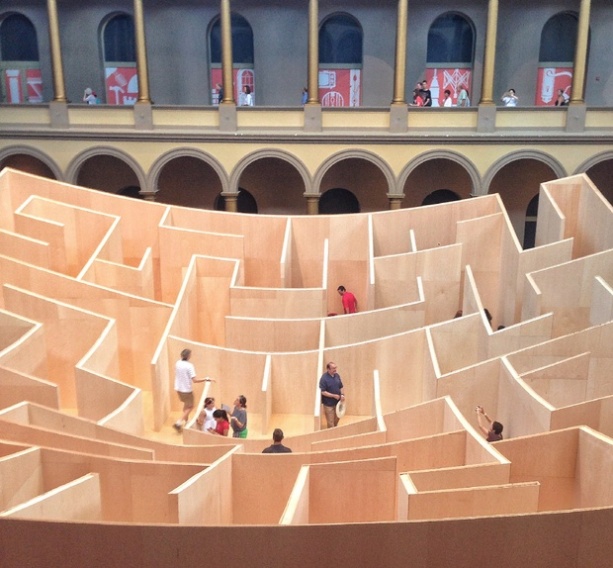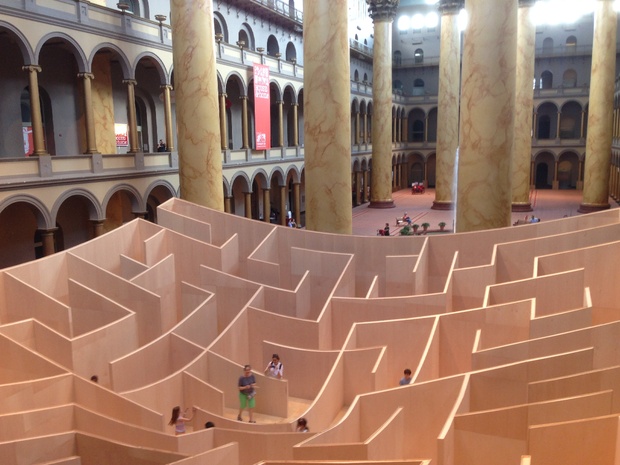A Maze of a View
Posted July 16, 2014

Perspective is the theme of the week on the ESI blog. We are looking at some concepts and practitioners who work at changing our view and understanding of the environment. The last post looked at Felice Varini’s installation paintings and how they shifted perspective and were dependent upon point of view in the built environment.
This post is inspired by an equally entertaining project and this one is taking place now. If you have perused the design blogs over the past several days, you will probably know that the famed Bjarke Ingels Group has erected a wooden maze in the National Building Museum. Opening on July 4th, the BIG Maze will stay up through the summer as part of the museum’s Summer Block Party and has already attracted crowds that try to beat its circuitous route.

The BIG Maze is 3,000 square feet of baltic birch plywood that rises 18 feet high on its exterior edges and is 57 feet long. The team at BIG designed the maze to be engaging at all three dimensions, up, down, to, and fro. The top of the maze is open, as a Victorian garden maze was open to the sky, so that the maze participants can view the amazing structure of the galleries above from a new viewpoint.
On the museum’s website, Bjarke Ingels is quoted.“The concept is simple: as you travel deeper into a maze, your path typically becomes more convoluted. What if we invert this scenario and create a maze that brings clarity and visual understanding upon reaching the heart of the labyrinth?”

The 18 feet high exterior walls form a cube that sits imposingly in the eastern edge of the museum’s Great Hall. The inside reverses the “lost” perspective for one of evolving clarity. The closer one gets to the center of the maze, the more understanding the maze participant gains. Once at the center, a 360 degree view reveals one’s path in and the path out.
The Bjarke Ingels Group is not averse to creating altered expectations from their designs. Headquartered in Copenhagen, the firm has also designed a waste incinerator plant with a ski slope as an exterior facade. The exhaust port on the top of the waste center emits rings of steam in a timed fashion, so that the municipal building becomes a central timepiece for the entire city.
The starchitects have been making a name for themselves over the past several years in creating these altered perspectives that force urban dwellers to rethink their surroundings. Their designs play an important role in reversing the insular nature of city life. We as urban dwellers have a tendency to put our heads down and hurry through our commutes, our daily habits, our coffee breaks, and the other acts we consider mundane. But design has the ability to force us out of our cocoon and view the world with an altered sense of seeing.
In this way we can truly re-see the world around us. Design is not only important functionally. Design also reimagines the physical world by creating difference, forcing impediments to normalcy, and by stretching the boundaries between expected and unexpected. A project like the BIG Maze in the National Building Museum is a perfect example of when and how design can be positively employed to alter our perspective and thus create new experiences from the resulting point of view.
For more info, check out these great write ups on the BIG Maze: CityLab, DesignBoom, and Architectural Record. Featured image from Architectural Record.


Join The Conversation